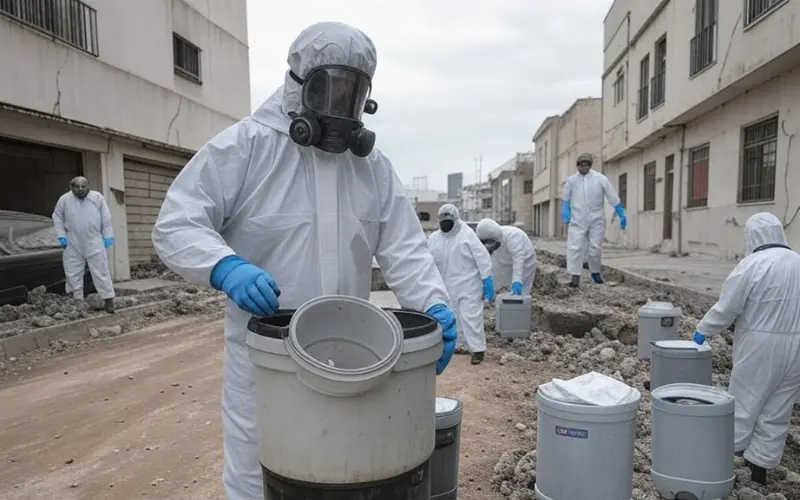Earthquakes can result in extreme structural damage, releasing dangerous substances like asbestos. Asbestos, prevalent as a component of construction materials due to its fire-resistance and insulation qualities, is hazardous when its resting place is disturbed. Airborne asbestos fibers, if inhaled, can cause severe illnesses like asbestosis, lung cancer, and mesothelioma. After the earthquakes, asbestos should be safely disposed of and handled to avoid exposure to these toxic fibers. Take appropriate action immediately to evaluate, contain, and remove asbestos-contaminated debris properly.
Need renovation or decoration services? Click here to contact causticoo.
Finding Asbestos in Earthquake-Damaged Buildings
Earthquakes often lead to scenarios where asbestos could become a significant health risk if not managed correctly. Understanding the relationship between earthquakes and asbestos exposure is crucial for public safety.
- Asbestos products in some form or another exist in most buildings erected before the 1980s, which include:
- Roofing materials
- Ceiling tiles
- Insulation
- Pipe wraps
- Floor coverings
- Cement sheets
In the aftermath of earthquakes, it is vital to assess the potential presence of asbestos in the damaged structures to ensure safety.
Emergency responders should be trained to identify the risks of asbestos during earthquake assessments to protect themselves and the public.
Earthquakes can cause hidden asbestos dangers, and restricting access to affected areas is essential for safety.
These materials may break during an earthquake and release tiny asbestos fibers into the air. To contain health risks, trained asbestos inspectors must thoroughly examine before any cleanup or demolition.
After earthquakes, using proper protective equipment (PPE) is even more critical when dealing with asbestos to prevent exposure.

Precautions to Take When Handling Asbestos Following an Earthquake
During cleanup after earthquakes, wet methods significantly reduce asbestos fiber release into the air.
Restrict Access to Affected Areas
Earthquakes can disturb asbestos materials, and it is important never to break or disturb asbestos during post-disaster cleanup.
Keep the affected area and the debris out of reach until professionals assess to avoid asbestos exposure. Warning signs must be erected around the perimeter of the affected area.
Use Proper Protective Equipment (PPE)
- Proper PPE must be worn by all persons working with asbestos, including:
- Respirators (N-100 or P-100 filters)
- Disposable coveralls
- Gloves
- Protective footwear
- Goggles and headgear
Use Wet Methods for Asbestos Containment
Misting asbestos debris with water dramatically minimizes the risk of airborne fibers release. Low-pressure misting avoids disturbing asbestos particles while handling.
Never Break or Disturb Asbestos Materials
Deteriorated asbestos material should not be cut, sanded, drilled, or broken because this is the greatest likelihood of maximizing fiber release. Experts should instead remove contaminated material in solid pieces wherever possible.
Properly Seal and Contain Asbestos Waste
After removal, asbestos waste must be double-bagged in 6-mil thick polyethylene bags and put in leak-tight, labeled containers. Each container will have to be labeled “Asbestos Hazard” before shipping.
Regulatory compliance ensures that asbestos removal is handled safely in the wake of earthquakes, protecting both workers and the public.
Safe Disposal of Asbestos-Contaminated Debris
Transportation of Asbestos Waste
Asbestos waste has to be transported according to local and federal laws. Asbestos waste haulers that specialize in the work ought to be employed to meet hazardous material disposal regulations.
Public awareness about the dangers of asbestos is especially important after earthquakes when structures may be compromised.
Disposal in Authorized Asbestos Landfills
Not all landfills will take asbestos waste. Waste disposal must be done at EPA-approved landfills specifically designed to dispose of hazardous waste. Check with local environmental officials to see the location of the nearest approved landfill.
Government support is pivotal in ensuring safe asbestos handling during recovery from earthquakes.
Regulatory Compliance
Asbestos disposal is regulated by adherence to stringent legal standards, among them being regulated by:
U.S. Environmental Protection Agency (EPA)
Occupational Safety and Health Administration (OSHA)
National Emission Standards for Hazardous Air Pollutants (NESHAP)
State and local environmental officials
Record Keeping and Documentation
Conclusion: Proper management of asbestos emissions during earthquakes is crucial for minimizing health risks in affected communities.
Disposal records must be maintained in good order to ensure compliance with environmental regulations. Examples of such records are waste shipping records, landfill receipts, and removal reports.
Our other services : Remove Asbestos in Vancouver
Public Awareness and Community Protection Measures
Public Awareness of the Dangers of Asbestos
Community members should be informed about the dangers of asbestos exposure and taught how to deal with it safely in case of an earthquake. Public notices, pamphlets, and websites may be employed to raise awareness.
Government and NGO Support
Non-governmental organizations (NGOs) and local governments contribute significantly towards relief efforts following a disaster through funding, training, and equipment for safe asbestos removal and disposal.
Emergency Planning Response
Asbestos management procedures must be included in disaster response plans that earthquake-prone communities need to establish. This preventive action minimizes health risks following an earthquake.
Proper disposal of asbestos following earthquakes is essential to the recovery process of the disaster. We can reduce the risk of asbestos exposure and safeguard public health by enforcing strict safety measures, using certified personnel, and complying with laws. Governments must prioritize education, enforcement, and public participation to make the cleanup process safe and effective.
Conclusion
Safe removal of asbestos following earthquakes is critical to disaster recovery. Following safety protocols, using accredited professionals, and obeying the law can minimize asbestos exposure and keep individuals healthy. Officials must prioritize educating the populace, enforcing the law, and engaging the community so that the cleanup can continue safely and without a hitch.



